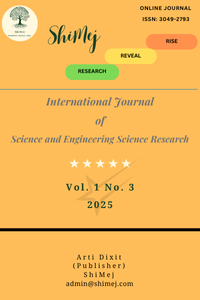Mathematical Modelling of India's Population Dynamics: A Comprehensive Analysis of Projection Methodologies and their Socio-Economic Implications
DOI:
https://doi.org/10.5281/zenodo.17048355Keywords:
Mathematical modelling, Sustainable development, Demographic, Resources, Environmental pressuresAbstract
This paper provides a comprehensive analysis of mathematical modeling techniques for projecting India's population, which has recently become the world's largest, making accurate forecasting a critical prerequisite for national planning. The study undertakes a comparative evaluation of two primary classes of projection methodologies. First, it examines non-age-structured models, including the exponential and logistic growth curves. An application of these models to India's historical census data reveals their inherent inadequacy for reliable, long-term forecasting, primarily due to their simplifying assumptions of homogenous populations and static environmental carrying capacities, which fail to capture the complexities of human demographic transition.
In contrast, the paper details the robust, age-structured cohort-component method, which is the standard employed by official bodies such as the Registrar General of India (RGI). By incorporating age- and sex-specific rates of fertility, mortality, and migration, this method accurately models the crucial dynamics of population momentum and population aging. The analysis discusses the practical application of this method through computational tools like the Spectrum-DemProj module, which allows for dynamic policy simulation.
The study critically analyzes the official projections from the RGI, which forecast India's population to reach 1.52 billion by 2036. Beyond this headline figure, the projections reveal a nation undergoing a profound demographic shift, characterized by a rapidly closing window of opportunity for a "demographic dividend," significant population aging with the elderly cohort (60+) expected to more than double, and accelerating urbanization that will account for nearly three-quarters of all population growth.
The socio-economic and environmental implications of this trajectory are explored in depth. The paper investigates the dual challenge of capitalizing on the demographic dividend through strategic investments in education, skill development, and job creation, while simultaneously managing the escalating environmental stress on critical resources, including land, water, and air, driven by both absolute population numbers and rising consumption patterns. The paper concludes by synthesizing these findings, affirming the superiority of age-structured models for policy formulation, and advocating for an integrated, rights-based policy framework. This framework must move from a paradigm of "control" to one of empowerment through choice and reproductive health, while proactively planning for an aging society and promoting sustainable development to ensure a resilient and equitable future.
Downloads
Published
How to Cite
Issue
Section
License
Copyright (c) 2025 International Journal of Science and Engineering Science Research

This work is licensed under a Creative Commons Attribution-NonCommercial 4.0 International License.






